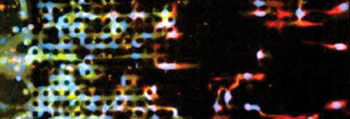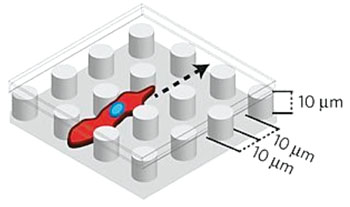Microfluidic Device Monitors Key Step in Development of Tumor Metastases
By LabMedica International staff writers
Posted on 03 Sep 2014
A device has been developed that may help study key steps in the process by which cancer cells break off from a primary tumor to invade other tissues and form metastases.Posted on 03 Sep 2014
The microfluidic device described as an EMT chip, where EMT stands for epithelial-mesenchymal transition, reveals a fundamental change in cellular characteristics that has been associated with the ability of tumor cells to migrate and invade other sites in the body. Therapies that target this process may be able to slow or halt tumor metastasis.
Bioengineers at Massachusetts General Hospital (Boston, MA, USA) who developed the device allows investigators to follow the movement of cells passing through a comb-like array of micropillars, which temporarily separates cells that are adhering to each other. To establish baseline characteristics of noncancerous cells, the investigators first studied the passage of normal epithelial cells through the array. They observed that those cells moved at the same speed as neighboring cells, reconnecting when they come into contact with each other into multicellular sheets that repeatedly break apart and reseal. Tumor cells, however, passed quickly and more directly through the device and did not interact with nearby cells.
When cells in which the process of EMT had been initiated by genetic manipulation were observed passing through the device, at first they migrated collectively, but soon after encountering the first micropillars, many cells broke away from the collective front and migrated individually for the rest of their trajectory. Some cells appeared to undergo the opposite transition, reverting from individual migration back to collective migration. Subsequent analysis revealed that the slower moving cells that continued migrating together expressed epithelial markers, while the faster moving, independently migrating cells expressed mesenchymal markers. The individually cells migrating also appeared to be more resistant to treatment with chemotherapy drugs.
Daniel Irimia, MD, PhD, an assistant professor of Surgery and the senior author of the study, said, “This device gives us a platform to be used in testing and comparing compounds to block or delay the epithelial-mesenchymal transition, potentially slowing the progression of cancer. Instead of providing a snapshot of cells or tissues at a specific moment, as traditional histology studies do, the new chip can capture the changing dynamics of individual or collective cellular migration.” The study was published on August 17, 2104, in the journal Nature Materials.
Related Links:
Massachusetts General Hospital
















